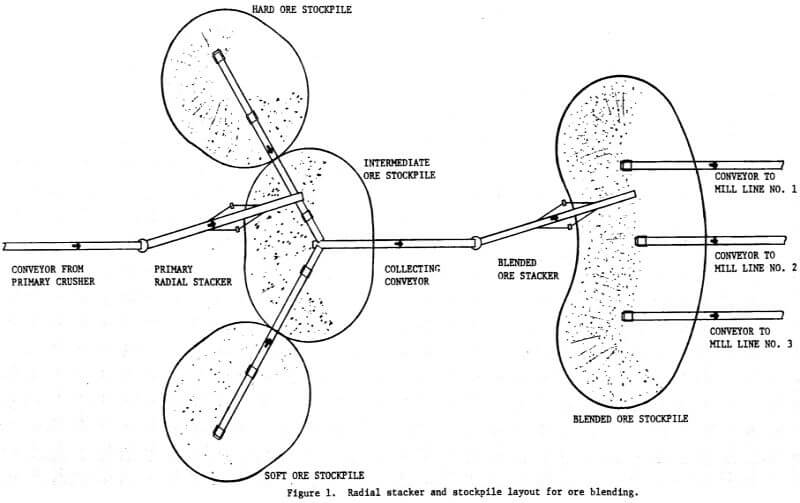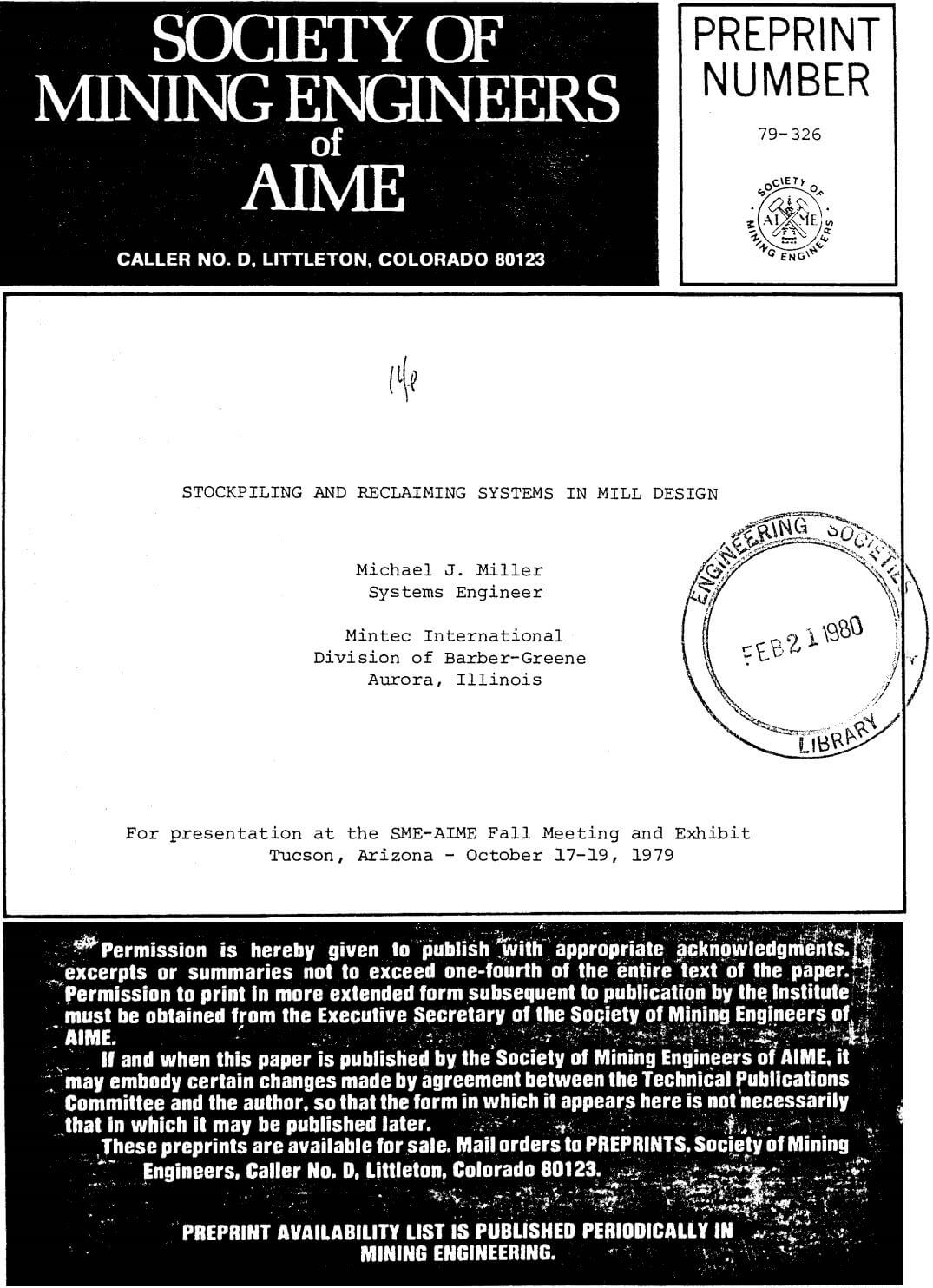Table of Contents
Belt conveyors are the most commonly used means for building stockpiles. The usual types are the fixed stacker, radial stacker, traveling stacker, shuttle conveyor and tripper conveyor.
Fixed Stacker
The fixed stacker is an inclined belt conveyor that is normally cantilevered at the head end in order to avoid having conveyor supports in the stockpile where they would be subject to corrosion and mechanical damage. Because of the physical limitations mentioned in the preceeding section, stockpile heights for fixed stackers are usually under 30m (100 ft.); however, in some special circumstances, higher fixed stackers may be justified.
The only type of blending possible with a fixed stacker is by building up successive layers of the ores to be blended. Blending occurs as the material is reclaimed. This does not provide very satisfactory results in most cases since the percentage of each of the ores in the stockpile is fixed once the stockpile is built and, due to the configuration of the withdrawal cones as compared to the stockpile, the ore reclaimed from the live storage portion will have a mix that Is different from the mix in the dead portion of the stockpile. A more satisfactory arrangement is to have several fixed stackers building conical piles of different ores which are reclaimed separately and then combined to form the mill feed mixture.
Dusting can be a serious problem with fixed stackers since the maximum drop when the stockpile is low can be considerable. One common way of effectively limiting dusting is to use a telescoping chute attached to the head end of the stacker. Although such a chute does limit dusting, it adds a great deal of weight to the head end (which is cantilevered over the pile) and it introduces its own problems of reliability since the control and hoisting mechanisms for a telescoping chute can be somewhat complex. It is also advisable to reinforce the stacker truss and supports to the points where they can handle the load if the chute plugs and fills with ore. If this additional load is not considered, there is a real danger of the stacker collapsing if the chute does plug up.
An alternative to the telescoping chute is the lowering tube, a device which has found wide acceptance in the coal industry. Basically, the lowering tube consists of a large diameter tube, usually about 2m (6 ft.) in diameter which acts as a chute and as a support for the head end of the stacker. “Windows” are cut in a spiral pattern on the tube for almost its full length and are covered by rubber sheets which form a dust seal. As material falls into the lowering tube, it builds up until it reaches the first window where it spills out and starts to form the stockpile. This process continues as the material builds up from one “window” level to the next until the stockpile reaches its maximum height. Obviously, the lowering tube must be heavily reinforced to withstand the stresses that are imposed on it in the center of the stockpile. Lowering tubes are normally restricted to applications where abrasion and corrosion are not serious problems.
A second alternative to the telescoping chute is an enclosure over the entire stockpile. Traditionally, these enclosures have been conical structures of corrugated galvanized steel sheeting with suitable reinforcing members; recently, however, several stockpiles have been covered successfully with an air supported structure of waterproof synthetic fabric. These enclosures provide the additional benefits of keeping the stockpile dry and of preventing the wind from picking up dust from the stockpile itself. The cost for a stockpile enclosure may be prohibitive when compared to the cost of a telescoping chute.
Figure 2 shows a fixed stacker building a stockpile directly over a reclaim tunnel. Note that extensive dozing of the stockpile has been done to provide a large dead storage capacity. This material would have to be dozed back into the live storage area for reclaiming by the tunnel conveyor.
Radial Stacker
A second type of stockpiling belt conveyor is the radial stacker. The radial stacker is basically similar to the fixed stacker except the entire frame is mounted on a set of wheels and can rotate about a pivot near the tail end. This permits the building of kidney-shaped stockpiles which greatly increases the total storage capacity for a given length of conveyor. The stockpiles formed by two radial stackers are shown in Figure 1.
The radial stacker can be designed with a boom at a fixed elevation or a boom which has a variable discharge height. This variable height minimizes dusting and segregation problems. A radial stacker with a fixed boom can be fitted with a telescoping chute but the problems indicated in the fixed stacker section arise here also. The most commonly used method of limiting dusting with a radial stacker is to build a conical pile and then slew the stacker about 3m (10 ft.) so that the discharge stream falls on the side of the conical pile rather than all the way to the base. Obviously, the fixed height radial stacker is simpler and less expensive than the variable height stacker. It is, therefore, advantageous to use the fixed height stacker if possible.
The two types of radial stackers in common use are the cable hung and the underslung truss type. The cable hung type consists of a tower structure from which the conveyor boom is suspended by cables which may be fixed or attached to a hoist for varying the discharge height. The underslung truss type consists of a conveyor boom attached to a wheeled support and may also be of the fixed or variable height type. Figure 3 shows a fixed height underslung truss type radial stacker. The underslung truss type radial stacker is generally more rigid due to the inherent differences in the method of support, but either type can be designed to meet the requirements of most applications.
An important point to note on Figure 3 is the use of the existing terrain. As shown in the photograph, the tail end of the stacker has been located at a higher elevation than the base of the stockpile. This provides greater stockpile height and hence greater storage capacity for this size stacker than would be possible on a level site. Utilizing the existing terrain also reduces the amount of cutting and filling required to provide a suitable stockpile site. Whenever possible, the existing topography should be incorporated into the design of a stockpile system.
The maximum height of a stockpile for a radial stacker is governed by the allowable soil bearing pressure. With an allowable bearing pressure of 14 680 kg/m³ (3000 lb/ft³), a material with a density of 1600 kg/m³ (100 lb/ft³) and an angle of repose of 38 degrees, the maximum stockpile height is about 18m (60 ft.). If the ore could be conveyed at an angle of 18 degrees, the radial stacker required to build the maximum size stockpile would only have to be about 65m (215 ft.) long. With the above figures and a 60 degree arc of travel, the radial stockpile has a total capacity of about 61 000 metric tons (67 000 short tons). If the arc of travel is increased to its practical maximum of about 300 degrees, the total stockpile capacity rises to about 235 000 metric tons (260 000 short tons). Obviously, a substantial portion of the 300 degree stockpile would be dead storage and would have to be dozed for reclaiming. The purpose of these figures is to show that it is possible to stockpile very large quantities of ore with relatively modest equipment.
Traveling Stacker
The traveling stacker consists of a conveyor belt tripper mounted on a wheeled structure which straddles a feed conveyor (yard belt) and supports one or two boom conveyors for building stockpiles. See Figures 4 and 5. A special variation is the slewing traveling stacker which has a single boom conveyor which can be swung to either side of the yard belt conveyor to build stockpiles. Figure 6 shows a variable height, slewing traveling stacker in operation. Traveling stacker booms may be of the fixed or variable height configuration. Normally traveling stackers are used in stockpile systems with capacities in the range of 200 000 metric tons (220 000 short tons) or more. Consequently, yard belts in excess of 600m (2000 ft.) are not uncommon. Boom conveyors usually are in the 30-60m (100-200 ft.) range.
Blending is accomplished by layering, building separate stockpiles and reclaiming simultaneously, or, in the case of the slewing traveling stacker, by laying down windrows of alternating types of ore to build the stockpile. Upon reclaiming, the stockpile made of windrows blends together better than the layered pile.
Variable height, slewing traveling stackers can also be fitted with a reversing boom conveyor which permits their use in conjunction with a bucket wheel reclaimer for stockpile reclaiming. Such units are usually involved in applications requiring 100% reclaim and flow rates on the order of 1800-6000 metric tons/hr (2000-6600 short tons/hr). In some cases, the bucket wheel is mounted on the end of the stacker boom itself rather than being a separate unit.
Shuttle Conveyors
The shuttle conveyor is a horizontal, reversible conveyor mounted on wheels within a fixed supporting structure running the length of the stockpile. The shuttle conveyor is fed by another conveyor, usually at a right angle to the shuttle’s centerline and at the center of the stockpile. Since the shuttle can reverse the direction of its belt travel and can traverse back and forth, it need be only slightly longer than one-half the stockpile length in order to discharge material anywhere along the full length of the stockpile. For this reason, it is generally less expensive than the tripper conveyor which must be the same length as the stockpile. For practical operation, the shuttle is limited in length since the entire shuttle conveyor must be moved back and forth. Shuttle conveyors rarely exceed 45m (150 ft.) in length and therefore usually serve stockpiles with ridge lengths of 90m (300 ft.) or less. Stockpile heights are usually limited to about 18m (60 ft.) or less due to the resultant support spans and soil loads.
The above stockpile dimensions give a total capacity of about 78 000 metric tons (86 000 short tons) with 1600 kg/m³ (100 lb/ft³) material. Shuttle conveyors are normally limited to enclosed storage systems since alternative outdoor systems such as the traveling stacker or radial stacker are usually less expensive for a given stockpile capacity.
Blending with the shuttle conveyor is accomplished by building separate stockpiles and reclaiming simultaneously or by building a layered stockpile. Dusting is controlled by discharging the ore onto the side of the stockpile or by enclosing the entire stockpile and shuttle supporting structure.
Tripper
The tripper conveyor consists of a horizontal conveyor supported over the stockpile and a tripper carriage which traverses the length of the stockpile. Pulleys on the tripper are arranged so that the material on the belt is discharged onto a short chute attached to the carriage. The chute directs the material onto the stockpile. In practice, the stockpile height under the tripper conveyor is usually limited to about 18m (60 ft.) for the same reasons as with the shuttle conveyor above; however, the tripper conveyor can theoretically be unlimited in length. The practical limits of travel for the tripper conveyor are determined by economic comparisons with alternative stockpiling systems. Trippers are normally utilized for enclosed storage systems because, although they may be used for outdoor storage, alternative systems such as the traveling stacker are usually less expensive.
Blending and dusting are handled in the same way as with the shuttle conveyor above.

